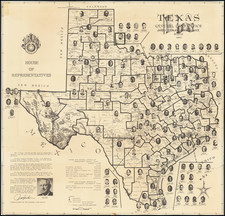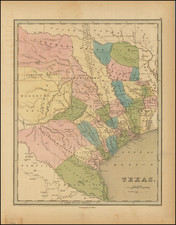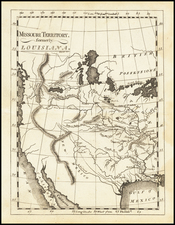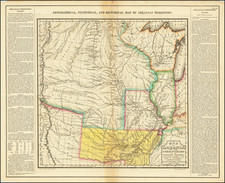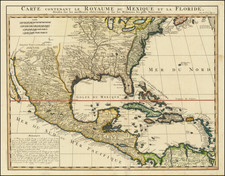Manuscript Map and Translation of Mexican Land Grant of the Lands of Adolphus Sterne -- Endorsed by James Harper Starr, First President of the Board of Land Commissioners of the General Land Office of Texas
Finely crafted cadastral map illustrating about a 15 mile section of land along the Neches River on the eastern border of Tyler County, identifying the land owned by a number of early Texas land owners, including Adolphus Sterne, an important early Jewish Texas settler, whose claim to one league of land is identified in Green at the center.
The map is accompanied by an 1867 translation of an 1835 grant of one league of land, made by the Mexican state of Coahuila and Texas to settler Adolphus Sterne (1801-1852). The translation is signed by Fred W. Moore, chief clerk of the Texas General Land Office and the Spanish translator, Edward Linn, and provides a translation of the original grant to Sterne
Sterne was an important early Jewish settler of Texas who resisted the Mexican government as early as the 1825 Fredonian Rebellion, was a friend of Sam Houston, served as a militia commander, and had a seat in the legislature for Nacogdoches. This translation was commissioned in 1867, 15 years after his death. The plat map was drawn and signed by James Harper Starr of Nacogdoches, who had been first President of the Texas General Land Office, treasurer of the Republic of Texas, and an important local official, who then operated one of the first banks in Texas. He presumably traced the map from the original in the Mexican land records.
The purpose of the map was to accompany an 8 page "Translation of Title to One League of Land" to Adolpho Sterne. The original date of title is hown on the verso as October 21, 1835, with attestation on the verso signed by W.D. Kincaid, dated July 9, 1867. Sterne arrived in New Orleans in 1817, where he remained until 1825 or 1826, moving to Nacogdoches, where he established a mercantile business. Shortly thereafter, he begn smuggling guns in aid of the Fredonia Rebellion (1826-27), a 2 month attempt by Anglo settlers in Texas to secede from Mexico, led by Haden Edwards. The rebels created the Republic of Fredonia, which lasted less than 2 months. Among those who opposed the newly created Republic was Stephen F. Austin, who convinced local Native American tribes not so support the rebellion.
The map is endorsed by James Harper Starr, with a fee of $0.50 noted. Starr, who served as the first President of the Texas General Land Office. The names listed on the map include:
- A[dolphus] Sterne
- J.J. Pemberton
- Ephraim Thompson
- Norman Hurd
- Theophilus Cushing
- J.T. Clark
- T.D. Evans
- W.W. Nelson
- J.E. Thompson
- A. Beyerty
- W. Spurlock
- B. Enlee
- C. Morgan
Nicholas Adolphus Sterne (1801 – 1852) served three terms in the Texas House of Representatives and one term in the Texas State Senate. He immigrated to the United States from Germany in 1817, living in Louisiana for ten years. In 1826, he moved to Nacogdoches, Texas, where he operated a mercantile and smuggled weapons for the colonist who wished to rebel against Mexico. His position as a Freemason helped save him from a death sentence, and Sterne went on to finance the two companies of men known as the New Orleans Greys, to assist in fighting in the Texas Revolution. Sam Houston lived with Sterne and his wife, during which time he was baptized. While Sterne's wife served as godmother, Sterne refused to be godfather, because the ceremony occurred on Yom Kippur. Sterne also worked as an interpreter in English, French, Spanish, German, Yiddish, Portuguese, and Latin.
The following is excepted from the Texas State Historical Association on line Biography:
. . . Republic of Texas treasurer, land agent, banker, and Confederate officia. . . . He moved to Georgia in 1832 and practiced medicine at McDonough and later at Pleasant Grove. He and his wife, the former Harriet J. Johnson (daughter of Samuel Johnson), moved to Nacogdoches, Texas, on January 17, 1837, with other Georgians.
On December 14, 1837, the Texas Congress established the General Land Office, and President Sam Houston selected Starr as president of the board of land commissioners and receiver of the land dues for Nacogdoches County. On May 25, 1839, President Mirabeau B. Lamar appointed Starr secretary of the Texas treasury. For financial reasons he asked permission to resign as treasurer on May 30, 1839, and his resignation was accepted on August 31, 1840, after which he began to administer the estate of his brother-in-law, Frost Thorn.
Starr became a land agent for those who exchanged land for Republic of Texas debts, and he supported the annexation of Texas to the United States. . . In 1844 he became a land agent in partnership with Nathaniel C. Amory. Due to Starr's reputation as an authority on Texas land laws, the agency grew and served as a bureau for advertising Texas land to prospective settlers from all parts of the United States. Starr and Amory remained partners until 1858, when Amory returned to Boston. . . Starr was opposed to secession and the election of delegates to the Secession Convention, but like many other Texans supported the Texas Confederate state government. His sons, Frank and Amory Starr, and son-in-law, Henry W. Raguet, volunteered for Confederate service and served in the New Mexico campaign. After the Congress of the Confederate States passed the Sequestration Act in 1861, Starr was appointed to act as a receiver in the enforcement of the laws and served until 1864. In 1863 he was appointed Confederate agent for the postal service west of the Mississippi River. His public career ended with the surrender of the Southern armies in 1865.
In 1868 Starr formed James H. Starr and Son, a land and banking agency, in Marshall, one of the first banks in Texas. He moved his family to Marshall in 1870, and he and Frank Starr retired in 1873, when Amory Reily Starr gained control of the family firm. J. H. Starr spent the later part of his life at his home in Marshall, and continued to advise clients on Texas land. He was offered appointment as one of the first regents of the University of Texas but declined due to poor health.











